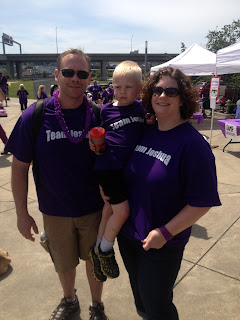I ended up speaking again this year at the opening ceremonies and it was a last minute thing so I wrote my speech the night before. It was easier to talk this year as I was not nearly as emotional as I was last year and I really wanted to get my message across. Last year everything was so new and overwhelming an this year I felt like I had a purpose to my speech. I wasn't sure how well it would go over, but everyone seemed to like it and I even had a total stranger come up and hug me afterward just to say thank-you for sharing our story. Others told me they liked hearing about the diet as they had not heard too much about it before. It felt good to stand up there and tell everyone about the miracle of the diet and maybe, just maybe someone in the audience will try it for their child or themselves and find some relief - that would be wonderful.
Below are some pics from the walk and at the end is the speech I gave in case you want to know what I said. I was going to post a video of me talking, but I don't think anyone I know actually ended up videoing it. Dang! :-)
The 4 of us!
Cole & his friend Ryder
Reece, Cole, Ryder & Owen
The back of Team Joshua's shirts - The Brain Defenders!
Me with Janette and Lisa
The 4 of us again!
Rhubarb with Ben, Owen, Reece & Cole
Rhubarb with Joshua
Joshua with another mascot
Me with Amy and Jenny
Me and Joshua
My Mom (Nana), Joshua & Me
Chip, Joshua and Me
Banner
Janette wrote this on the sidewalk
Me speaking during opening ceremonies
Cole getting his face painted
Speech:
FIRST – Thank you to all of you for being here to help raise money and awareness for epilepsy. It is those of you out there that are making the difference and we appreciate it so much!
I was asked to give my perspective on epilepsy from a parent’s point of view and our journey since it all started 18 months ago and I could, but it would be quick and not very helpful. Simply put - it is hard. That is it. No more, no less – just incredibly hard. watching your child seize and not be able to stop it. So, instead I am going to focus on two things that have become my passion since epilepsy entered our lives.
1) Advocating
for epilepsy funding and why it is important.
2) Dietary
Therapy as a “real” treatment option for people with intractable epilepsy
So, why is funding
for epilepsy important? Let me give you
some facts:
• 65 Million people worldwide have epilepsy
•
About 2.7 million
Americans have epilepsy with ~150,000 new cases each year
•
Epilepsy is the fourth
most common neurological disorder in the U.S. after
migraine, stroke,
and Alzheimer’s disease.
• 1 in 26 people will develop Epilepsy in their lifetime
• 1 in 10 people will suffer a seizure in their lifetime
disease, multiple
sclerosis and cerebral palsy combined
•
50,000 people die from epilepsy-related causes in the
United States every year
•
That is more than from breast cancer! Funding:
Each year the
government spends $30 billion on medical research at the National Institutes of
Health. Yet just ½ of 1% is spent on
epilepsy.
Public and private funding for epilepsy research lags far
behind other neurological afflictions, at $35 a patient (compared, for
instance, with $129 for Alzheimer’s and $280 for multiple sclerosis).
•
Pharmaceutical investment in epilepsy
is less than in Alzheimer’s and
Parkinson’s, and it’s expected to decline
further over the next several years.
contributes less to epilepsy
than it does to other major neurological disorders.
patient to epilepsy
research. Parkinson’s, by contrast, receives $40-50 per patient
from
nonprofits.
•
Therefore, per researcher, funding for
epilepsy lags behind average funding for
all
diseases by nearly 50%.
Please support epilepsy funding and research by continuing to talk about epilepsy and its effects on those suffering from it and their families long after today. We need your help!
My second passion – Dietary Therapy
Dietary therapy (Ketogenic,
MAD, etc.) are REAL options and don’t ever let anyone tell you different and
please don’t discourage anyone who wants to try it. Is it Difficult? Yes, it is!
Is it worth trying? Yes it is!
•
3 medications – nothing helped
•
4 seizure types
•
Trouble walking, talking, “high” on
meds, speech, motor, cognitive declines
•
Behavioral issues, sleep issues, etc.
•
Started on MAD over 1-year ago, moved
to Keto 7 months ago
o Drop
seizures stopped in two weeks
o Daytime
seizures stopped in two months
•
Long periods of seizure freedom – 50
days
•
Two medications weaned off
•
Speech therapy and physical therapy no
longer needed
•
Almost completely normal EEG
•
Cognitive gains weekly
•
Less behavior issues
•
Smiles and hugs
•
Energy – having fun – plays with his
brother
•
No naps needed
Diet
therapy saved my Joshua when Anti-Epileptic Drugs (AEDs) could not.
Diet therapy should be considered by every doctor and every parent of a
child with intractable seizures. What do
you have to lose except some seizures??
Thank
You,

















Wonderful news!! We are still fighting the beast. We did not walk in the Seattle location this year, as Ethan was not doing well. We are completely off of meds, and just on the keto diet. At first we saw seizure freedom. But now we are having to adjust calories and such, as he is way more active off of the meds. and have seen the seizures return. Thanks for posting. It is great to know that Joshua is doing well!! We still need to get together sometime. :)
ReplyDeleteGreat post!
ReplyDelete